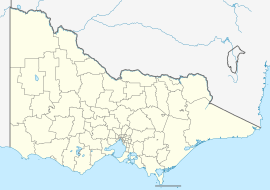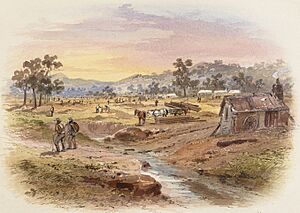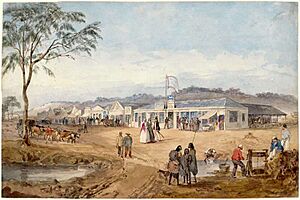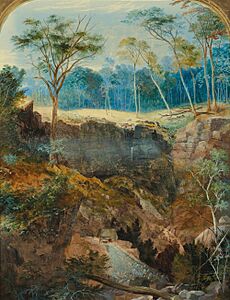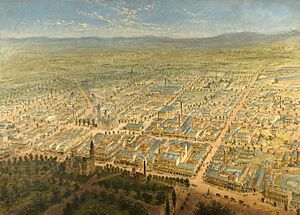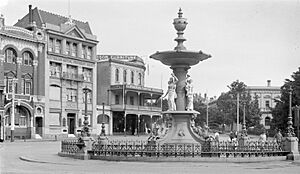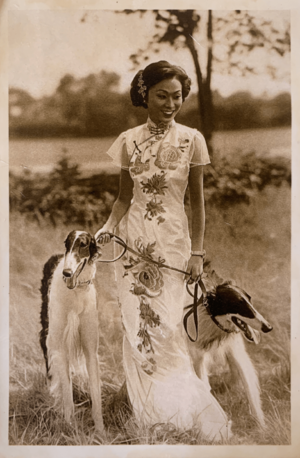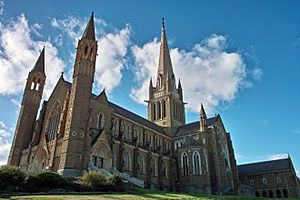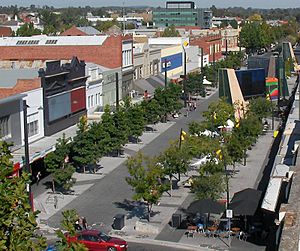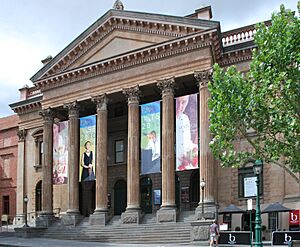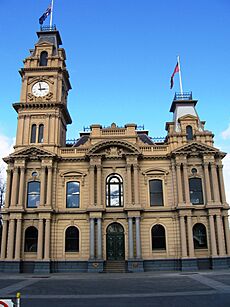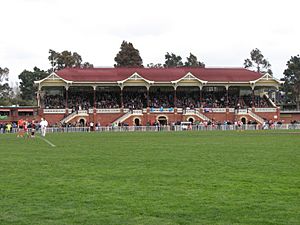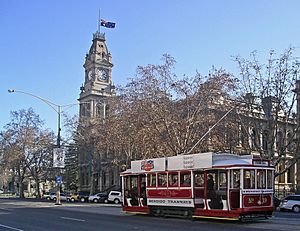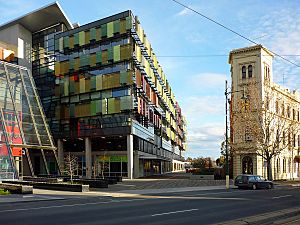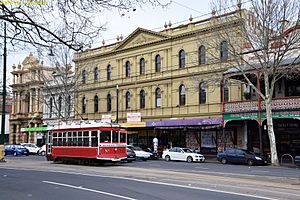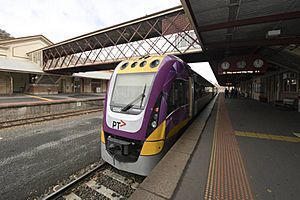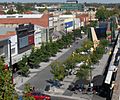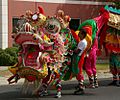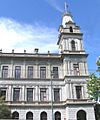Bendigo facts for kids
Quick facts for kids BendigoVictoria |
|||||||||
|---|---|---|---|---|---|---|---|---|---|
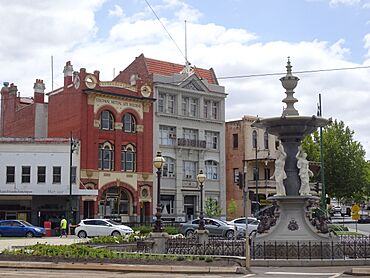
Bendigo city centre
|
|||||||||
| Population | 103,034 (2021) (19th) | ||||||||
| • Density | 358.50/km2 (928.5/sq mi) | ||||||||
| Established | 1851 | ||||||||
| Postcode(s) | 3550 | ||||||||
| Elevation | 213 m (699 ft) | ||||||||
| Area | 287.4 km2 (111.0 sq mi)(2016 urban) | ||||||||
| Time zone | AEST (UTC+10) | ||||||||
| • Summer (DST) | AEST (UTC+11) | ||||||||
| Location | |||||||||
| LGA(s) | City of Greater Bendigo | ||||||||
| Region | Loddon Mallee | ||||||||
| County | Bendigo | ||||||||
| State electorate(s) |
|
||||||||
| Federal Division(s) | Bendigo | ||||||||
|
|||||||||
Bendigo is a city in central Victoria, Australia. It is about 150 kilometres (93 miles) north-west of Melbourne, the state capital. Bendigo is located in the Bendigo Valley.
As of 2022, Bendigo has a population of over 103,000 people. This makes it Australia's 19th-largest city. It is also the fourth-largest inland city in Australia. Bendigo is the fourth most populated city in Victoria.
The local government that runs Bendigo is called the City of Greater Bendigo. This area covers about 3,000 square kilometres. Bendigo is surrounded by smaller towns like Castlemaine and Heathcote.
The traditional owners of this land are the Dja Dja Wurrung (Djaara) people. Gold was found on Bendigo Creek in 1851. This discovery quickly turned the area from a sheep station into a huge boomtown. Many people came from all over the world, especially Europe and China, during the Victorian gold rush. Bendigo became the biggest gold-mining area in Eastern Australia in the 1800s. The wealth from this time can still be seen in the city's beautiful Victorian buildings. From 1853 to 1891, Bendigo was officially called Sandhurst.
Bendigo's gold boom lasted until the early 1900s. After a short dip in population, the city started growing again in the 1930s. It became a centre for manufacturing and services in the region. Gold mining still happens, but most new growth is in the suburbs. The Calder Freeway now connects Melbourne and Bendigo. This has made Bendigo one of the fastest-growing regional centres in Victoria.
Contents
- History of Bendigo: From Gold Rush to Modern City
- Geography and Climate: Exploring Bendigo's Environment
- People and Culture: Discovering Bendigo's Community
- City Life: Exploring Bendigo's Urban Structure
- Culture and Events: What to Do in Bendigo
- Sports in Bendigo
- Economy: How Bendigo Makes a Living
- Infrastructure: Getting Around and Staying Connected
- Sister Cities
- Notable People from Bendigo
- Images for kids
- See also
History of Bendigo: From Gold Rush to Modern City
Who Lived in Bendigo First? Indigenous History
The Dja Dja Wurrung (Djaara) people are the traditional owners of the land around Bendigo. They used the rich hunting grounds for many years. In 1837, European settlers arrived and started large sheep farms. This meant the Dja Dja Wurrung people lost their land. The arrival of new animals also caused problems. For example, pigs dug up the important "moon-nar tuber" (yam daisy) plant, making it scarce.
Gold was officially found on Bendigo Creek in October 1851. The creek was named "Bendigo Creek" after a local shepherd. He was nicknamed "Bendigo" because his boxing style was like a famous English boxer, William "Bendigo" Thompson. In less than a year, tens of thousands of people arrived. This was during the great gold rush of 1852.
All the gold mining caused a lot of damage to the environment. It also harmed the Dja Dja Wurrung people and their way of life. The channels and weirs they built to manage water were destroyed. Water holes became muddy or drained. This made it very hard for them to find clean water.
How Gold Changed Bendigo: The Gold Mining Boom
Gold was officially discovered in October 1851. Many gold diggers came from nearby Castlemaine. In less than a year, the population grew to 40,000 people. Many of these diggers were Chinese, and their families still live in the area today.
In 1852, William Swan Urquhart helped plan the town of 'Sandhurst', which is now Bendigo. He marked out areas for the town and suggested places for schools, churches, and markets.
In 1853, there was a big protest called The Red Ribbon Rebellion. Miners were unhappy about the high cost of the gold licence fee. Luckily, police and miners' leaders handled it peacefully. The town quickly grew from a collection of tents into a major city. Many grand public buildings were built. In 1863, the area became a borough. It was officially known as Sandhurst until 1891, but people always called it Bendigo.
The railway reached Bendigo by 1862. This helped the city grow even faster. New industries started, like flour mills, woollen mills, and foundries. When the easy-to-find gold ran out, miners started digging deep shafts to find gold in quartz rock.
Bendigo's Growth and Modern Changes
Bendigo was declared a city in 1871. With more people, there was a shortage of water. A new viaduct was built to bring water from the Coliban River.
The architect William Charles Vahland (1828–1915) designed many important buildings in Bendigo. He is known for the "Vahland House" cottage design. These houses often had a central door, windows on each side, and a long hallway. They also featured verandas with iron lace. Vahland designed over 80 buildings, including the famous Alexandra Fountain. This fountain has granite dolphins, unicorns, and other figures. A tram network was set up by 1890. Some of these trams are still used today for tourism.
After a temporary dip in population, Bendigo started growing again in the 1930s. It became a centre for manufacturing and services. Gold mining still continues today. Recent growth has been mostly in suburbs like Epsom and Kangaroo Flat.
In 2013, the Dja Dja Wurrung people were officially recognised as the traditional owners of part of Central Victoria, including Bendigo.
In 1994, the City of Bendigo joined with other nearby towns and shires. This created the larger City of Greater Bendigo. The city's population grew from about 78,000 in 1991 to over 100,000 in 2012. Bendigo is now one of the fastest-growing regional centres in Victoria.
Geography and Climate: Exploring Bendigo's Environment
What is Bendigo's Natural Surroundings Like?
The city of Bendigo is surrounded by parts of the Greater Bendigo National Park. It also includes the Bendigo Box-Ironbark Region Important Bird Area. This area is important for birds like swift parrots. Many insect-eating bats and the grey-headed flying fox also live here.
What is the Weather Like in Bendigo?
Bendigo has a fairly dry temperate climate. Summers are warm and changeable, while winters are cool. Bendigo gets about 110 clear days each year.
In January, the average lowest temperature is 14.4°C (57.9°F). The average highest temperature is 30.3°C (86.5°F). Temperatures often go above 35°C (95°F). The highest temperature ever recorded was 45.9°C (114.6°F).
In July, the average lowest temperature is 2.7°C (36.9°F). Temperatures below 0°C (32°F) happen about 26 nights a year. The average highest winter temperature in July is 12.7°C (54.9°F). Most of the city's average yearly rainfall of 510.0 mm (20.1 inches) happens between June and September. Snow is rare, but sleet can occur. Frosts are common in winter and spring.
Extreme Weather Events in Bendigo
Bendigo has experienced big floods in the past, including in 1859 and 1903.
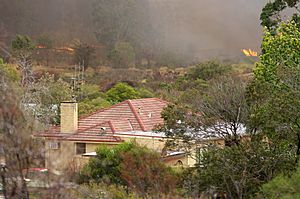
Tornadoes are rare but have happened around Bendigo. In 2003, a tornado caused major damage to homes and businesses.
From 2006 to 2010, Bendigo had a severe drought. There were very strict water restrictions. Heavy rains in late 2010 filled most reservoirs. Now, only wasteful water use is banned.
Bendigo was affected by the Black Saturday bushfires in 2009. A fire west of the city burned about 500 hectares (1,200 acres). It destroyed about 58 houses in the western suburbs. One person died in the fire.
Flash floods have also occurred in Bendigo, including in 2010, 2022, and 2024.
People and Culture: Discovering Bendigo's Community
Who Lives in Bendigo? Demographics
According to the 2016 census, 92,379 people lived in the Bendigo Urban Centre.
- Aboriginal and Torres Strait Islander people made up 1.8% of the population.
- 84.6% of people were born in Australia. Other common birthplaces included England (1.6%), India (0.7%), and New Zealand (0.6%).
- 88.1% of people spoke only English at home. Other languages included Karen (0.9%) and Mandarin (0.5%).
- The most common religions were No Religion (36.2%), Catholic (22.0%), and Anglican (12.9%).
In 2019, the estimated population for the City of Greater Bendigo was 118,093.
What Religions are Practised in Bendigo?
In the 1800s, Catholicism was the main Christian religion in Bendigo. A priest named George Henry Backhaus helped build the first church, St Kilian's, in 1858. He left his money to the church, which helped build Sacred Heart Cathedral in 1897. This cathedral is the third-largest church building in Australia. In 2016, 22% of the population were Catholic. However, 36.2% reported having "no religion."
Chinese miners, who made up 20% of Bendigo's population in the mid-1800s, built the Bendigo Joss House Temple. This temple is dedicated to Kwan Tai. They practised a mix of beliefs, including ancestor worship and the main religions of China: Buddhism, Taoism, and Confucianism. Bendigo is also home to the Great Stupa of Universal Compassion. This is the largest stūpa in the Western world. It houses the Jade Buddha for Universal Peace, the world's largest jade Buddha statue. In 2016, Buddhism was followed by 1.4% of people in Bendigo. In 2019, construction began on Bendigo's first mosque and Islamic community centre.
City Life: Exploring Bendigo's Urban Structure
What Does Bendigo's City Centre Look Like?
The central area of Bendigo, called the CBD, has about 20 blocks with different types of buildings. The main street is the Midland Highway, and the part that goes through the CBD is called Pall Mall.
What are Bendigo's Suburbs Like?
The main urban area of Bendigo covers about 82 square kilometres. The suburbs generally follow the Bendigo Creek and its smaller streams.
Bendigo has many suburbs. Some, like Eaglehawk, used to be separate towns. Many suburbs also extend into the surrounding bushland.
| Name | Population (2021) | Postcode |
|---|---|---|
| Ascot | 2,571 | 3551 |
| Bendigo | 5,652 | 3550 |
| Big Hill | 281 | 3555 |
| California Gully | 4,476 | 3556 |
| Eaglehawk | 5,538 | 3556 |
| Eaglehawk North | 0 | 3556 |
| East Bendigo | 2,246 | 3550 |
| Epsom | 5,014 | 3551 |
| Flora Hill | 3,989 | 3550 |
| Golden Gully | 213 | 3551 |
| Golden Square | 9,220 | 3555 |
| Huntly | 3,585 | 3551 |
| Ironbark | 1,163 | 3550 |
| Jackass Flat | 1,907 | 3551 |
| Junortoun | 3,862 | 3551 |
| Kangaroo Flat | 11,328 | 3555 |
| Kennington | 5,880 | 3550 |
| Long Gully | 3,420 | 3550 |
| Maiden Gully | 5,407 | 3551 |
| North Bendigo | 4,277 | 3550 |
| Quarry Hill | 2,365 | 3550 |
| Sailors Gully | 743 | 3556 |
| Spring Gully | 3,092 | 3550 |
| Strathdale | 5,756 | 3550 |
| Strathfieldsaye | 6,850 | 3551 |
| West Bendigo | 378 | 3550 |
| White Hills | 3,620 | 3550 |
What are Bendigo's Famous Buildings? Architectural Heritage

Because of the gold boom, Bendigo has many beautiful buildings from the late Victorian era. Many of these are protected heritage sites. Important buildings include the Bendigo Town Hall (1859), the Old Post Office, and the Shamrock Hotel (1897).
The architect William Vahland helped bring European artists to Bendigo. He wanted to create a "Vienna of the South." Bendigo's Sacred Heart Cathedral is a huge sandstone church. It is the third-largest cathedral in Australia. The main part was finished between 1896 and 1908.
Fortuna Villa is a large Victorian mansion that still stands today. Bendigo also has other classic buildings like the Colonial Bank (1887). The historic Bendigo Joss House was built in the 1860s by Chinese miners. It is the only one of its kind in regional Victoria that is still used for worship. The old Bendigo Tram Sheds and Power Station (1903) now house the city's tram museum.
Where Can You Relax? Parks and Gardens
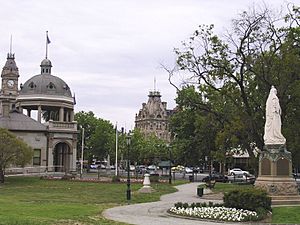
Rosalind Park is a Victorian-style garden near the city centre. It has statues and a large stone viaduct. At the main entrance, called Charing Cross, you'll find a big statue of Queen Victoria.
The Charing Cross area also has the large and fancy Alexandra Fountain (1881). The park goes up towards Camp Hill, which has an old school and a lookout point.
Further from the city is Lake Weeroona. This is a large, pretty lake next to Bendigo Creek. The Bendigo Botanic Gardens, which opened in 1869, are also nearby. These gardens have been redeveloped recently.
The gardens are home to many native animals. These include possums, ducks, owls, and the tawny frogmouth. There is also a group of endangered grey-headed flying foxes.
Culture and Events: What to Do in Bendigo
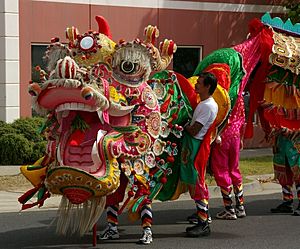
The Bendigo Art Gallery is one of Australia's oldest and largest regional art galleries. In 2012, Princess Charlene of Monaco visited for an exhibition about Grace Kelly.
The Capital Theatre is next to the art gallery. It hosts plays, music, and the annual Bendigo Writers Festival.
The Ulumbarra Theatre opened in 2015. It used to be the old Bendigo Gaol (jail). The new theatre seats almost 1,000 people. It keeps some of the old jail's features. It hosts performing arts, music, and is used by local schools and universities.
Bendigo hosts the Bendigo National Swap Meet for car parts every November. It is said to be the biggest in the Southern Hemisphere.
The city also hosts the Victorian part of the annual Groovin' the Moo music festival. This festival brings many Australian and international music acts to Bendigo.
The Bendigo Blues and Roots Music Festival happens every November. It features over 80 artists. The main event is a free concert in Rosalind Park.
The Bendigo Easter Festival is held every year. It brings thousands of tourists to the city. It includes parades, exhibitions, and a street carnival.
The Bendigo Queer Film Festival (BQFF) is one of Australia's few regional festivals that celebrates queer films. It started in 2004.
The Festival of Light is a multicultural celebration of peace and harmony. It is inspired by the Buddha's birthday and held every May at the Great Stupa.
In 2019, Bendigo was named a United Nations' City of Gastronomy. This means it's known for its food culture.
Bendigo has several amateur theatre groups, like the Bendigo Theatre Company.
Media and Music in Bendigo
Bendigo has two newspapers: the Bendigo Advertiser and the Bendigo Weekly. The Bendigo Weekly is now part of the Bendigo Advertiser on Saturdays.
There are eight local radio stations, including 105.1 Life FM and Hit 91.9. There are also community radio stations like Radio KLFM 96.5.
Television networks like Seven, WIN (Nine), Network 10, ABC, and SBS broadcast in the Bendigo region. WIN Television has a local news bulletin each weekday.
Many live music venues in Bendigo feature local bands. The Bendigo Town Hall also hosts music concerts. Bendigo has several choirs, including the Bendigo Youth Choir. There are also orchestras and bands.
Famous musicians from Bendigo include Patrick Savage, a film composer. Australian Idol winner Kate DeAraugo grew up in Bendigo.
Sports in Bendigo
Cricket and Football in Bendigo
Cricket and Australian rules football are the most popular sports in Bendigo. The Queen Elizabeth Oval (QEO) is used for both sports. The Bendigo and District Cricket Association manages 10 cricket clubs.
In Australian rules football, the Bendigo region has the historic Bendigo Football League. This league has 10 teams. The Sandhurst Football Club, founded in 1861, is one of the oldest football clubs in the world.
Other Sports in Bendigo
The Bendigo Cup is a well-known horse-racing event.
The Bendigo Stadium hosted basketball games during the 2006 Commonwealth Games. Bendigo's men's basketball team is the Bendigo Braves. The women's team, Bendigo Spirit, won the Women's National Basketball League championship in 2013 and 2014.
Bendigo also hosted the second Commonwealth Youth Games in 2004.
Economy: How Bendigo Makes a Living
Bendigo has a large and growing service economy. The main industries are health, finance, tourism, education, and food processing. There are also some important engineering companies.
Bendigo's growth has also helped nearby small towns like Elmore and Heathcote.
Tourism in Bendigo
Tourism is a big part of Bendigo's economy. It brings in over A$364 million each year. Bendigo is popular for its history and culture, especially its gold rush past. Popular attractions include the Central Deborah Gold Mine, the Bendigo Tramways, the Golden Dragon Museum, and the Bendigo Pottery.
Business and Finance in Bendigo
The main shopping area in Bendigo is the central business district. Suburbs like Eaglehawk and Kangaroo Flat also have shopping areas.
Bendigo is home to the headquarters of the Bendigo Bank. It started in 1858 as a building society. Now, it is a large bank with branches all over Australia. The bank is a major employer in Bendigo.
Manufacturing and Farming in Bendigo
About 10.2% of Bendigo's workers were in manufacturing in 2011. After the gold rush, deep gold mining led to a heavy manufacturing industry. Today, a large foundry (Keech Castings) makes parts for mining and trains. Thales Australia is an important engineering company. Australia Defence Apparel makes military uniforms.
The land around Bendigo is often rocky. It is used for timber and beekeeping. Sheep and cattle are raised in cleared areas. There are also some large poultry and pig farms. Wheat and other crops like canola are grown in more fertile areas. The region also produces good wines, especially Shiraz.
Bendigo provides services to a large farming area to its north.
Gold Mining Today
Bendigo was once the most productive gold area in Australia. From 1851 to 1954, the Bendigo gold field produced 777 tonnes (25 million ounces) of gold.
A lot of gold is still left in the Bendigo goldfields. It is thought that at least as much gold remains as has already been taken out. Gold mining slowed down partly because the mines became very deep and filled with water.
Infrastructure: Getting Around and Staying Connected
Transport in Bendigo
Bendigo is connected to Melbourne by the Calder Freeway. The drive takes less than two hours. This makes Bendigo an important city for transporting goods from northern Victoria to the Port of Melbourne.
Bendigo is a major rail hub for northern Victoria. Several train lines meet here, including the Bendigo line to Melbourne. V/Line runs regular passenger train services to Melbourne. The shortest trips take about 91 minutes.
There are several train stations in Bendigo. Three stations currently operate for passengers: Kangaroo Flat railway station, Epsom Railway Station, and Eaglehawk railway station. The Regional Rail Revival project is upgrading lines and building new stations. Goornong Railway Station opened in December 2021.
Victoria's electronic ticketing system, Myki, started on Bendigo train services in 2013.
Bendigo also has a large bus network. Buses mostly start from the city centre and go to the suburbs. There are also taxi services.
Trams in Bendigo used to be a main form of public transport. Now, they are mostly a tourist service.
Bendigo is served by the Bendigo Airport. It is north of the city. The airport has been upgraded with a new runway and lighting. In 2018, Qantas announced flights between Sydney and Bendigo. These flights started in March 2019.
Utilities: Water in Bendigo
Bendigo gets some of its water from Lake Eppalock. In 2007, a pipeline was built to bring water from Waranga to Lake Eppalock and then to Bendigo. In 1858, engineer Joseph Brady designed reservoirs and channels to bring water from the Malmsbury reservoir to central Victoria.
Sister Cities
Bendigo has sister city relationships with:
Notable People from Bendigo
Many interesting people have come from Bendigo, including:
Arts and Entertainment
- Harold Desbrowe Annear, architect
- Bunney Brooke, TV actress
- Amy Castles, singer
- Ola Cohn, sculptor
- Kate DeAraugo, 2005 Australian Idol winner
- Colleen Hewett, singer and actress
- Sam Jinks, sculptor
- Sarah McKenzie, jazz singer and pianist
- Virginia Trioli, journalist and TV host
- Lincoln Younes, actor
Business
- Fletcher Jones, Australian business owner
- Frank McEncroe, inventor of the Chiko Roll
- Sidney Myer, who started the Myer department stores
Politics
- Jacinta Allan, current Labor Premier of Victoria (since 2023)
- John Bannon, former Labor Premier of South Australia (1982–1992)
- John Brumby, former Labor Premier of Victoria (2007–2010)
- Sir John Quick, a politician who helped create Australia's Federation
Science
- Struan Sutherland, researcher who developed antivenoms
Sport
- Australian Football League players: Nathan Brown, Wayne Campbell, Nick Dal Santo, Jake Stringer, Troy Selwood, Adam Selwood, Joel Selwood, Scott Selwood, Greg Williams
- Billy Murdoch, Australian Test cricket captain
- Chris Hamilton, professional cyclist
- Faith Leech, Olympic swimming champion
- Kristi Harrower, Olympic basketball player
- Sharelle McMahon, Australian Netball Team captain
- Stephen Huss, 2005 Wimbledon men's doubles champion
Images for kids
-
Fire threatening houses in Long Gully, west of Bendigo, during the 2009 Black Saturday bushfires.
-
The Shamrock Hotel, first built in 1854 and rebuilt in 1897.
-
Rosalind Park with statues and grand buildings.
-
Sun Loong, the world's longest imperial dragon. It is a symbol of Bendigo's Chinese heritage and a highlight of the Easter Festival. You can see it at the Golden Dragon Museum.
See also
 In Spanish: Bendigo para niños
In Spanish: Bendigo para niños


